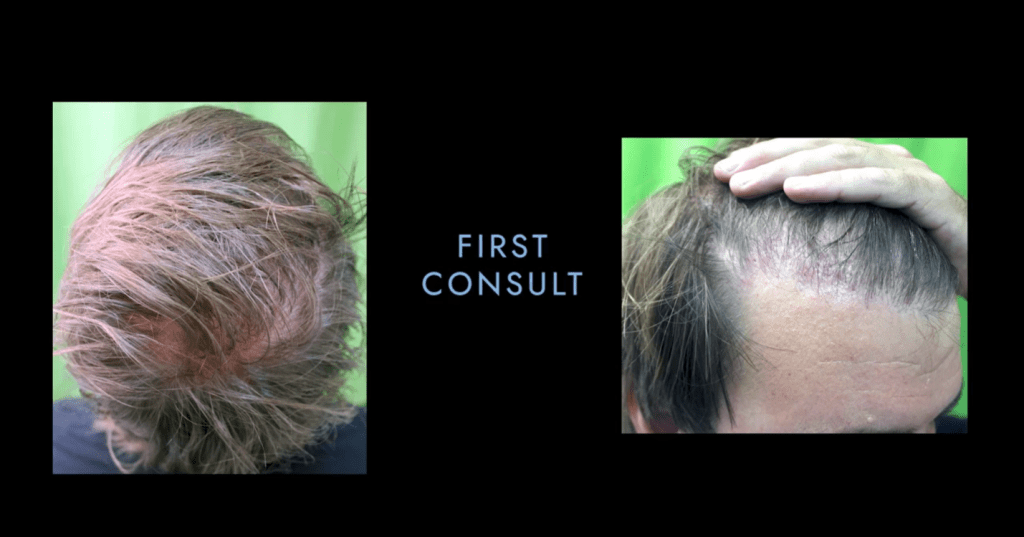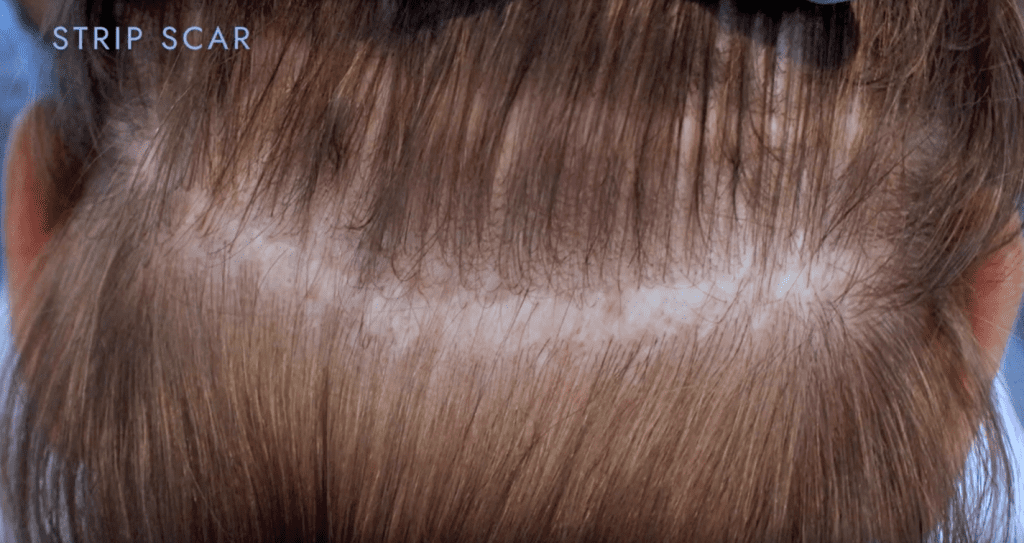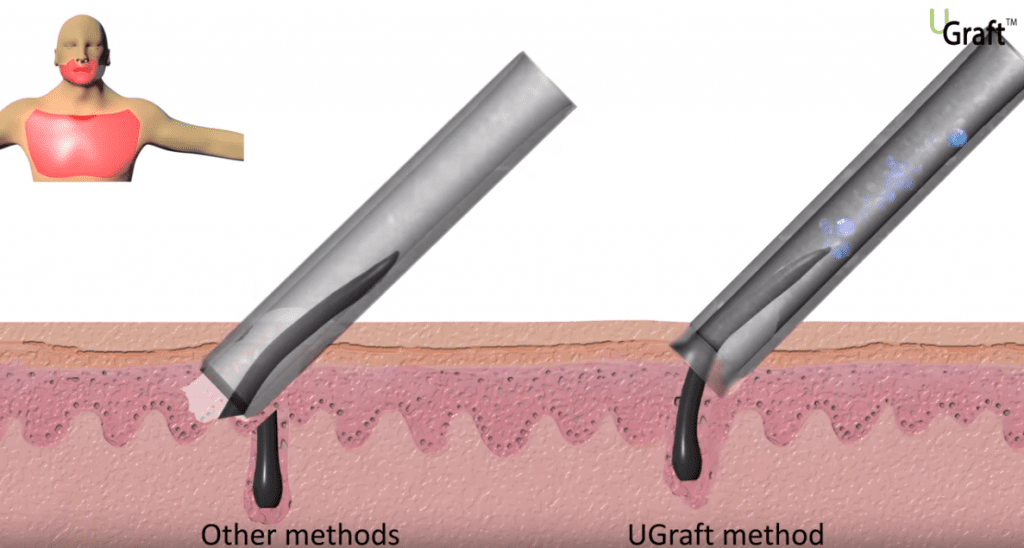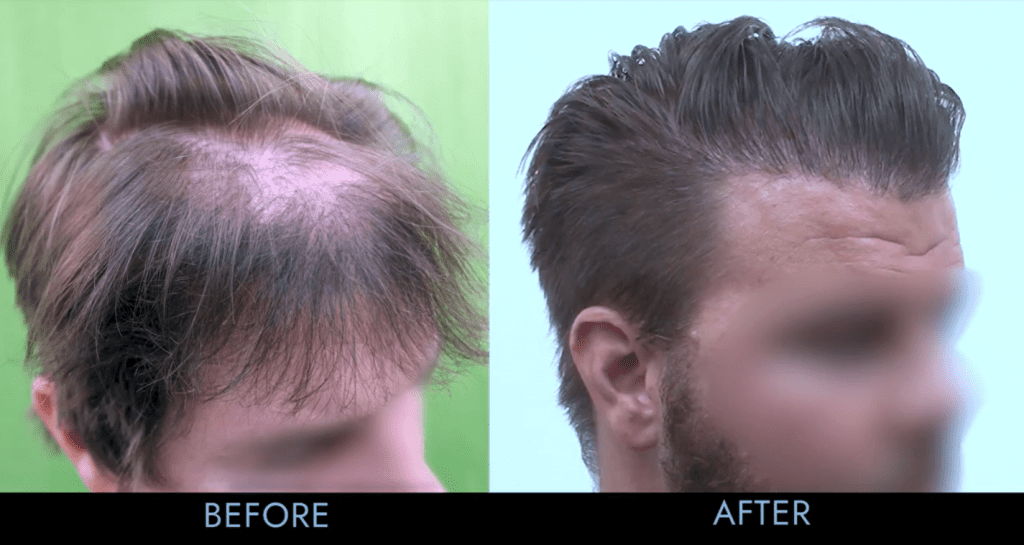If you’re currently considering a hair transplant, accessing a successful hair transplant before and after photos is a great first step on your journey. A patient from Sunland, CA, was a victim of a botched hair transplant surgery upon arrival to Dr. Umar’s office in late 2019. Continue to find out how Dr. Umar helped the patient feel like himself again after the surgery left him with an uneven hairline and a prominent linear scar. We’ll delve into his initial strip surgery (before), his body hair transplantation (after), and lastly, why the Dr. U approach to hair restoration is beneficial for body hair transplantation [1].
https://www.youtube.com/watch?v=nnd8as7PJHA&t=1s
Hair Transplant Before and After – Before Photos:
When the patient entered Dr. Umar’s office for the first time, he was no stranger to hair transplant surgery. The patient had undergone a FUSS (follicular unit strip) surgery in the past that had left him with an unsightly scar. FUSS is an outdated method because it requires a linear piece from the back or sides of the scalp to use as a donor strip. During FUSS surgery, the doctor removes a strip of tissue from the donor zone positioned at the back of the scalp (a.k.a. the occipital scalp) and bilaterally above the ears. The patient’s FUSS procedure also depleted the available pool of donor hair on his scalp. He asked for Dr. Umar to camouflage his scar, refine his hairline, frame his face better, and make his hairline look fuller.

;

Hair Transplant Before and After – Procedure Photos:
During his first surgery, the patient had 3443 grafts taken from his beard, head, nape, and leg and applied to his scar, hairline, frontal, and crown. At his second surgery, he had 826 grafts from his head applied to his frontal. Dr. Umar used 1206 grafts of the patient’s head and leg hair for application to the hairline and frontal during the third surgery.
Dr. Umar’s Dr.UGraft™ technology is beneficial for BHT because it can work with various follicle angles. If a follicle gets damaged during extraction, it won’t grow once it is transplanted. Dr. UGraft makes it possible to extract straight, coiled, curly, or wavy follicles sans damage. Although recovery time differs from patient to patient, the non-invasive nature of the process allows for patients to go back to their daily routine as soon as the procedure is over.

Hair Transplant Before and After – Results Photos:
To meet the patient’s wishes, Dr. Umar opted for a body hair transplantation (BHT) procedure using Dr. UGraft™’s technology. BHT involves sourcing hair from areas that aren’t the head, like the beard and other body areas, and grafting it onto balding areas on the head. There are four key benefits of using body hair as a source. First, expanding the donor pool to body hair allows even severely bald patients to receive treatment. BHT also gives the surgeon more hairs to choose from when looking for hair that would best imitate the hair’s natural look.
Next, androgen promotes body hair growth while facilitating loss of hair in androgenic alopecia (pattern baldness) — meaning patients will have plenty of hair to choose from on the body to replace the hair they’re losing on their head. Also, those who have depleted their donor hair from obsolete procedures like the patient have another chance at hair restoration thanks to the new donor source.

Video: Hair Transplant Before and After
Dr. Umar implemented the Dr.UGraft™ system to successfully perform a hair transplant with 5,375 grafts that achieved this patient’s objective to repair the botched hair transplant outcome.
How Dr.UGraft Got Even Better – The Zeus System
Since this patient’s procedure, Dr.Umar has continued to upgrade his hair transplant technology. The newest version of his system is known as the Dr.UGraft Zeus, which relies on a central touch screen console with preset punch performance capabilities based on skin thickness differences.
According to Dr.Umar, skin thickness is the number one cause of hair transplant graft transection, not hair curliness. Patients with thicker scalp skin and less curly hair can have much higher transaction rates than those with tightly curled hair and more average skin thickness levels.
Different patients across ethnic groups can be expected to have scalp tissue of varying densities. This will affect how FUE punches perform. Also, we have different skin thicknesses throughout our bodies. To successfully extract grafts from ethnic patients (e.g., blacks, Hispanics, Middle Easterners, etc.), punch performance would need to account for this variable. The same is true when it comes to harvesting donor hair from different parts of the body.
Interested in a Dr.UGraft procedure? Click here for a free online consultation with Dr.Umar
Frequently Asked Questions – Hair Transplant Before and After
What are the causes of no hair growth yield after a hair transplant procedure?
No hair growth yield can be a result of air exposure to the grafts during extraction. The exposure causes grafts to dry up and become less likely to grow. No hair growth yield can also be caused by mechanical damage due to human error when using surgical instruments. Common human errors include misaligning punches when trying to extract the grafts and causing damage due to forceps. To lower the chances of making these mistakes, Dr. U created the Dr.UPunchi ™ tool with specific features to overcome mechanical issues.
When does a Dr.UGraft™ body hair transplant use chest hair for donor grafts?
Chest hair for donor grafts is used when the head donor has been depleted either for natural balding or previously attempted procedures. It is softer than beard hair and can be blended with these grafts to supplement the overall graft count and help render a more natural-looking overall texture in the patient’s final coverage as it is blended in with the other types of hair. The use of chest hair is made possible by the Dr.UGraft™ system, which allows harvesting of hair from almost anywhere on the body.
When does a body hair transplant use beard hair for donor grafts?
The beard area is used to help expand the patient’s overall graft count in cases where the head hair is not enough to achieve the desired level of coverage (e.g., severe baldness and extreme hair transplant repair cases). Beard grafts are often implemented along with other body hair like head, chest, and nape hair to complete a transplant.
Why is the Dr.UGraft™ technology a necessary tool for extracting as many as 5,373 grafts?
The Dr.UGraft™ family of devices includes the rotary Dr.UPunchi™, which uses a subtle pulling action that uproots the graft as it cuts around the follicle. With this pulling action, the Dr.UGraft™ technology allows the removal of grafts with hair growing at any angle. Cutting away from the follicle, which faces a dull surface, is a feature that ensures the graft’s safety during the extraction process. And since body hair tends to grow at very sharp angles, regular cylinder punches would slice through the graft. So to extract 5,373 grafts, the doctor needs to rely on Dr. UGraft’s technology and the use of body hair.
References
- Umar S. The transplanted hairline: leg room for improvement. Arch Dermatol. 2012 Feb;148(2):239-42.
Further Reading
- Learn about the unethical practice of hair procedures being performed by non-physicians and the risks it poses to patients
- Prevent hair procedure disasters by learning about FUE hair surgery ethics and who is actually qualified to perform surgery


